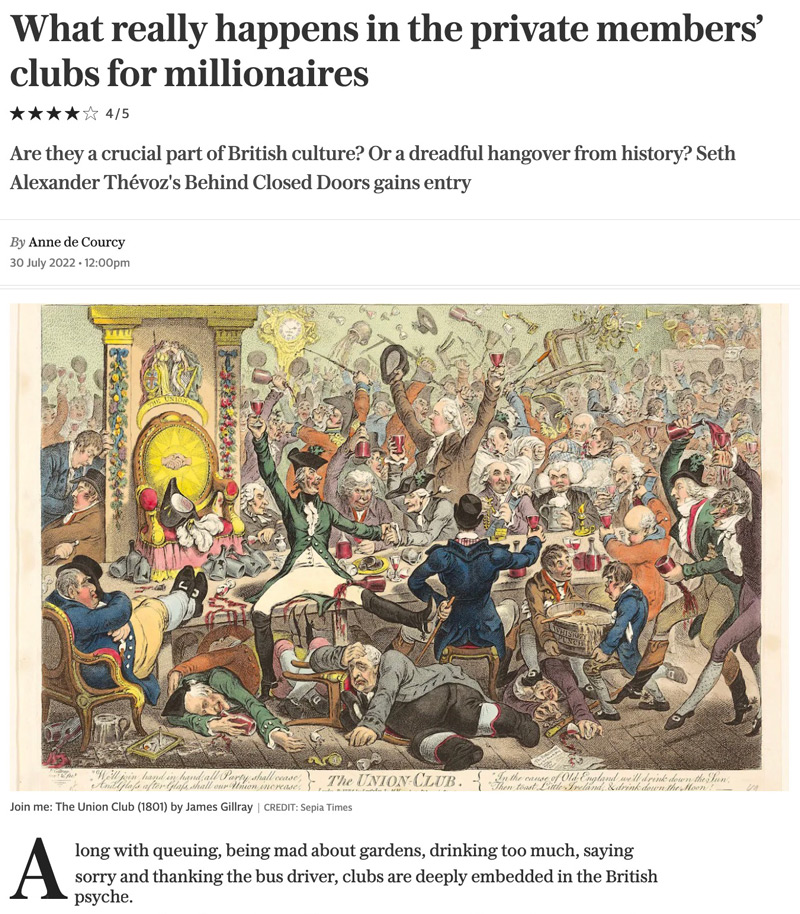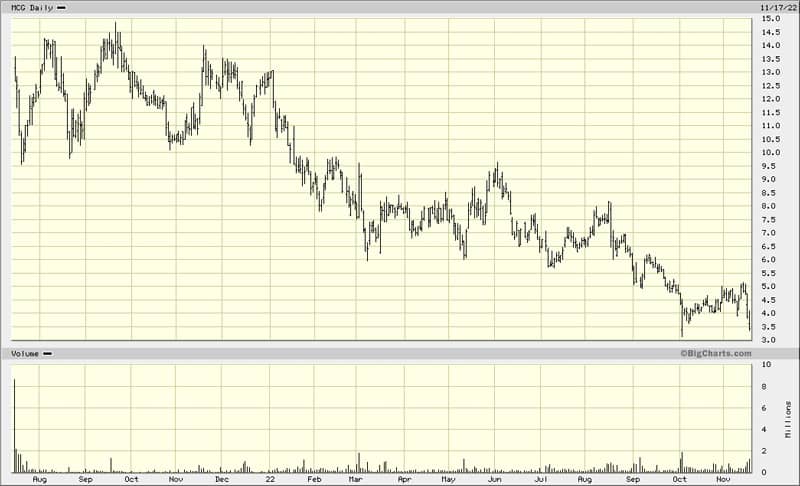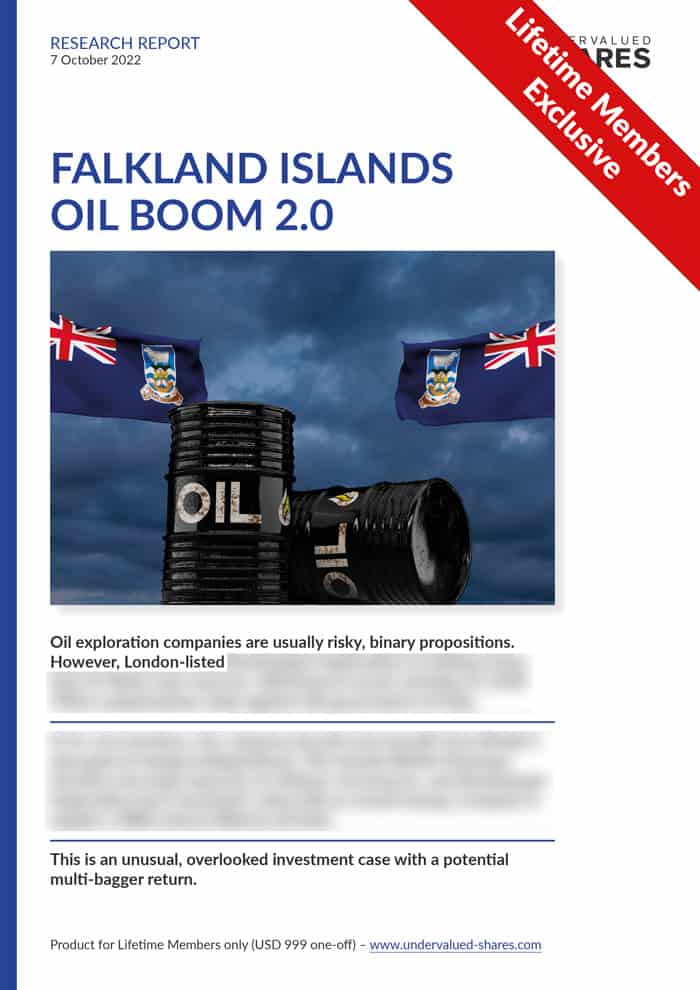Metals Exploration’s share price has gone vertical. What’s the key lesson, and which three stocks might be next?
Membership Collective Group – benefitting from the boom in private membership clubs?
Membership Collective Group isn't a particularly well-known public company because it has only been listed for just over a year, but its lead brand for private clubs is probably the world's best known: Soho House.
In July 2021, Soho House went public by merging with a SPAC. The reason why the listed company itself isn't called Soho House but Membership Collective Group, is because it also owns a variety of other clubs – making the stock a proxy for the private club industry.
Since the IPO, the stock of Membership Collective Group dropped 75%.
What makes the business model of private clubs so interesting? After losing three quarters of its value following the IPO, is the stock of Membership Collective Group a buy?
What are "private clubs" all about?
Private clubs are mostly associated with a bygone age, and often deemed a crucial part of British culture. At the heart of private members' clubs lies the idea that members dictate the rules and decide who may enter through that exclusive front door.
St James's in central London is sometimes referred to as "Clubland", as it historically hosted a large number of private clubs. The UK's capital once had 400 of such establishments but there are probably closer to 40 of them today, at least if you count the ones that are "established" enough.
There is the Carlton Club for members of the Conservative party, The Royal Automobile Club, and The Arts Club – to name just a few of the more prominent clubs.
"Clubland: The History of London Gentlemen's Clubs" – enjoyable eight-minute video (if slightly dated)
Most of these clubs live off some kind of perceived or real exclusivity, i.e. they make it difficult to become a member, or at least they try very hard to make it appear like it was difficult to get in. When the Daily Telegraph published a profile of some of the most exclusive private clubs in London, it described another famous club, White's, as follows:
"This secretive Mayfair club counts Prince Charles and Prince William among its members – the former even held his stag do here ahead of his wedding to Princess Diana. … Today, members lounge in the gaming rooms and sip whisky at the bar of a Grade I-listed building on St. James's Street. … It remains a men's-only institution, with women permitted entry as guests. To secure a spot, men require the backing of 36 members."
My own experience is that some of these clubs are actually rather desperate for paying members these days. Some clubs that used to be difficult to get into nowadays happily wave in anyone who looks half-way decent and is able to cough up a financial contribution. I shall not name names, of course.
Yours truly moved to London in 1998, and joined a club in the early 2000s: Annabel's, often said to be the world's most exclusive night club (which even the late Queen had visited in 2003). Private clubs tend to charge a premium price for wining and dining, and on top of that comes an annual membership fee. As Annabel's reveals on its website, membership is currently an annual fee of GBP 3,250. No figures are available about the size of its membership, but the publicly rumoured number of 30,000 strikes me as realistic given the enormous size of the club and the crowds it manages to attract on just about any given day of the week. This would give Annabel's a staggering income from membership fees alone of GBP 100m per year. Its premium-priced drinks, food, cigars, and event tickets come on top of that.
Not a bad business, if you can get it.
Buying into the private club business has long been difficult. Anyone who owns such a gem of a business tends to keep it to themselves instead of listing it on the stock market.
I have long followed this niche industry based on both professional curiosity and personal fascination. I even once met Nick Jones, founder of Soho House, arguably the best-known private club brand in the world. However, until July 2021 it made no sense for me to write about Soho House, since it only then became a company that members of the public could invest in through the stock market. That month, Soho House and a raft of other private clubs merged with a SPAC to form Membership Collective Group, a holding company for private clubs listed on the New York Stock Exchange.
Clubland met Wall Street, and it's been an interesting 15 months since the company's backdoor listing.

Source: Daily Telegraph, 30 July 2022.
A publicly listed private club (no pun intended)
Membership Collective Group's (ISIN US5860011098, NYSE:MCG) main asset is Soho House, a global chain of clubs that was originally aimed at those who work in the arts, politics, and media. The role that Soho House plays within the holding company is so prominent that the Financial Times refers to Membership Collective Group as "the Soho House owner" in headlines – else no one would be interested in reading the article.
When I moved to London at the turn of the millennium, Soho House was a single venue in the capital's Soho district. It was renowned for not wanting to let in members of the financial industry – wearing a suit and tie was a no-no. The brand's ethos was to put focus on creativity above net worth and job titles. As a member of Soho House, you were meant to be part of the cool kids, and it's this kind of branding that makes the concept of a private club so appealing. Once you are in, you are literally "in".
From its original location in 40 Greek Street in London, Soho House has expanded to encompass 38 Soho Houses around the world, as well as a number of other venues. It also operates nine Soho Works (workspaces), The Ned in London (a more exclusive private club for bankers), the Scorpios Beach Club in Greece's Mykonos, and Soho Home as an interiors and lifestyle retail brand.
What makes the concept so interesting for investors are the membership fees. Once a club has a desirable brand, it can collect high membership fees and be certain of a high retention rate of existing members. Being a member of the right kind of club allows you to signal your status, your profession, or your beliefs. Given how difficult the best private clubs are to get in, once you have the coveted membership you tend to keep it, even if you don't use it very often.
The company last reported 122,800 members globally, who pay an average fee of ≈USD 1,500 per year – that's before even spending a single dollar (pound, euro) on premium-priced coffee, wine, or food. Prices vary from country to country, depending on local purchasing power, and they vary from club to club. E.g., the cost of a UK membership to Soho House is now GBP 2,500 a year, up from GBP 1,750 in 2019. For a membership of Soho House in Berlin, the fees would be lower.
Despite the pandemic, the Membership Collective Group last reported an excellent retention rate of 95%.
What's more, it has a waiting list of currently 85,000 hopefuls who wish to be parted from their money. The waiting list has recently been at a record high.
Membership Collective Group is keen to use the momentum to expand further. At last count, it was planning to open seven new clubs this year, and five to seven new clubs in each of the following two years.
This was the growth story that Membership Collective Group used in mid-2021 when it went public. However, the stock has not fared quite as well as the strength of the brand would make you expect. The IPO was placed at the bottom of its range of USD 14-16, and the stock only briefly traded above its issue price. It has since sunk to USD 3.40, which is a 75% loss for anyone who subscribed to the IPO last year.
What happened, and is the stock worth a closer look now?

Membership Collective Group.
An unhappy relationship with financial markets
Before it went public as part of a larger group, Soho House has had a somewhat difficult relationship with the financial industry. Its policy to not admit finance professionals in the early 2000s made huge headlines at the time, and it turned out the market has the memory of an elephant.
In 2015, the company tried to bolster its fragile financial situation by placing a GBP 200m bond. As Reuters reported at the time:
"Soho House, the private members club that is famously resistant to financial professionals, faced a frosty reception from fixed income investors this week.
The private equity backed UK firm had to pull a planned £200m high-yield bond after investors baulked at the company's high leverage and limited free cashflow.
'It's pretty funny,' said one bond investor. 'They say that we're not cool enough to join their club but they're perfectly willing to take our money when they need it.' A second investor summarised the situation even more succinctly: 'We don't want you; we want your money!'"
Using the SPAC frenzy of 2020/21, Soho House and the other clubs grouped together under Membership Collective Group eventually did manage to raise USD 400m in equity. However, a closer look at the company's operative performance makes it questionable whether the stock is a good investment, even on its current level.
The Soho House clubs have had long-standing issues with profitability. Tellingly, the Membership Collective Group publishes an "adjusted EBITDA" figure. The reality behind that adjusted figure is bleak. Even though the company was able to recently double its adjusted quarterly earnings to USD 20.3m, it suffered a net loss of USD 91.7m. Its net debt swelled from USD 326.2m to USD 462.6m.
Only 19% of the company's debt of USD 698m is due in 2023 or 2024, and the motherload of its debt does not mature until 2027. Still, the market seems to have concerns whether Membership Collective Group can stay in business without hugely dilutive new funding.
Maybe these are the reasons why Nick Jones, the founder of Soho House, just announced his stepping down as CEO from the Membership Collective Group?
The past week's announcement is worth a closer look.
A huge warning signal
Nick Jones is Soho House, and Soho House is Nick Jones.
The 59-year-old founder of the company has been its face, global spokesperson and CEO ever since he set it up in 1995.
A few days ago, Jones announced that he was stepping down from his position as CEO of Membership Collective Group "to transition to the original role of founder". Given that "founder" is not a role as such, the announcement struck me as quite odd. Besides, a founder and large shareholder stepping back in some shape or form always makes a closer look worthwhile. It could be a sign of trouble, or one of opportunity – the latter, if a founder decides to hand over the reins to a manager who is better qualified to take a company to the next level. Creative people like Jones are often too much in love with the product, and not focussed enough on earnings.
Case in point, Jones justified his decision by saying that he "will focus on the creative and membership aspects of Soho House", and that his future work was going to make sure that "members had a good time".
As the ultimate reason for stepping down, Jones revealed that he had battled prostate cancer earlier this year. Even though he was healthy and cancer-free again, the experience had changed his "perspective and focus".
Much as he has all my sympathies for overcoming illness and shifting priorities, I struggle to believe that there aren't also other considerations.
Consider this. The clubs of Membership Collective Group have a record-long waiting list, and the company was recently able to significantly increase prices. Still, it's been losing money – and lots of it. If it isn't making any money now, when should it ever make money for its shareholders?
The recent era of cheap, abundant financing for growth companies is probably over for good. The market seems to sense that Membership Collective Group will eventually need additional funding. Financing costs are increasing, and raising equity can quickly become hugely dilutive if done on the back of an already weak share price. Despite its global brand and impressive list of venues and members, the stock of Membership Collective Group could remain under significant pressure.
Worse still, there is now the question whether Jones will try to cash in on his stake. He owns just 6% of the company, which is a little sad for a founder who has spent nearly three decades building the company, and indicative of how much external capital the business has required. Still, based on the current market cap of USD 760m, Jones's stake is currently worth ≈USD 45m. That'd be enough for a comfortable retirement. As CEO, he would have struggled to sell any of his shares without the market's confidence collapsing entirely. As retired CEO and figurehead who has had a life-changing health issue, Jones could probably get away with dumping stock.
Did Jones step down because he can sense difficult times ahead? Will he sell stock while his stake is still worth enough to sail off into a well-funded retirement?
Collective Membership Group has an enterprise value of ≈USD 1.5bn. Compared to its cashflow and financing needs, the stock still appears rather expensive. The new CEO claims to be all about earnings, but he is facing an uphill battle to make the market buy into his message. The day Jones stepped down, the stock dropped 18%.
Despite all my love for Clubland and many good evenings spent in Soho Houses around the world (as the guest of a member), I wouldn't touch the stock with a ten-foot pole. Still, it's worth keeping an eye on it, because the business model of a private club is rather interesting.
A multi-bagger from the Falkland Islands?
It's now only a matter of time before the investing public once again wakes up to the long-dormant subject of the Falkland Islands' oil reserves.
One company, in particular, is set to benefit. It is the only Falkland focussed firm that I believe is currently worth investing in in the short term. It comes with some incredible fundamentals, and a potential multi-bagger return.
Quite likely, this will be one of the more unusual investment cases you will have read about in recent times.
A multi-bagger from the Falkland Islands?
It's now only a matter of time before the investing public once again wakes up to the long-dormant subject of the Falkland Islands' oil reserves.
One company, in particular, is set to benefit. It is the only Falkland focussed firm that I believe is currently worth investing in in the short term. It comes with some incredible fundamentals, and a potential multi-bagger return.
Quite likely, this will be one of the more unusual investment cases you will have read about in recent times.
Did you find this article useful and enjoyable? If you want to read my next articles right when they come out, please sign up to my email list.
Share this post:








